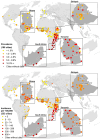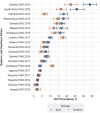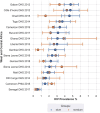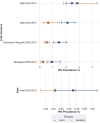Intersectional forces of urban inequality and the global HIV pandemic: a retrospective analysis
- PMID: 40204462
- PMCID: PMC11987103
- DOI: 10.1136/bmjgh-2023-014750
Intersectional forces of urban inequality and the global HIV pandemic: a retrospective analysis
Abstract
To determine how the intersection of increased urban growth and poverty has impacted HIV incidence and prevalence, given growing HIV inequalities globally. Retrospective analysis using combined data from five publicly available, population-level datasets to determine city- and within-urban countrywide estimates of 95-95-95 treatment targets, prevalence and incidence rates from 2015 to 2019. For city-level estimates, we analysed combined data from: Fast-Track City (FTC), SINAN from Brazil and UNAIDS Naomi-Spectrum. Countrywide estimates of HIV prevalence in the urban slum versus non-slum since 2012 were compiled from Population-Based HIV Impact Assessment (PHIA) surveys in 12 countries and Demographic Health Surveys (DHS) in 28 countries. HIV prevalence is generally higher among the urban slum, compared to their non-slum counterparts, thus resulting in national HIV estimates masking nuances in HIV inequalities between the urban slum and non-slum. Specifically, national and city-level HIV estimates mask inequalities within and between cities, with secondary cities often having higher HIV prevalence and incidence rates than capital cities and large urban areas. The urban divide between slum and non-slum populations is a contributor to HIV inequality, often with poorer outcomes in smaller cities than their larger counterparts. Interventions tailored to cities, and particularly those considering local nuances in subpopulations (eg, different genders, ages, roles), are necessary to reduce HIV inequality. Focused HIV programming accounting for structural drivers of inequalities between urban slum and non-slum populations such as inequalities in wealth, education, employment and housing are crucial to closing gaps driving HIV inequalities globally.
Keywords: Global Health; HIV; Public Health.
© Author(s) (or their employer(s)) 2025. Re-use permitted under CC BY-NC. No commercial re-use. See rights and permissions. Published by BMJ Group.
Conflict of interest statement
Competing interests: None declared.
Figures




Similar articles
-
The concentration of disadvantage and the rise of an urban penalty: urban slum prevalence and the social production of health inequalities in the developing countries.Int J Health Serv. 2009;39(4):749-70. doi: 10.2190/HS.39.4.i. Int J Health Serv. 2009. PMID: 19927413
-
The double burden of malnutrition in India: Trends and inequalities (2006-2016).PLoS One. 2021 Feb 25;16(2):e0247856. doi: 10.1371/journal.pone.0247856. eCollection 2021. PLoS One. 2021. PMID: 33630964 Free PMC article.
-
Assessment of knowledge, attitudes, and prevention practices regarding HIV/AIDS among urban slum dwellers in Bangladesh: an interview-based study.BMC Public Health. 2025 Feb 25;25(1):775. doi: 10.1186/s12889-025-21990-3. BMC Public Health. 2025. PMID: 40001071 Free PMC article.
-
The economics of healthcare access: a scoping review on the economic impact of healthcare access for vulnerable urban populations in low- and middle-income countries.Int J Equity Health. 2022 Dec 31;21(1):191. doi: 10.1186/s12939-022-01804-3. Int J Equity Health. 2022. PMID: 36585704 Free PMC article.
-
Systematic review of oral health in slums and non-slum urban settings of Low and Middle-Income Countries (LMICs): Disease prevalence, determinants, perception, and practices.PLoS One. 2024 Nov 8;19(11):e0309319. doi: 10.1371/journal.pone.0309319. eCollection 2024. PLoS One. 2024. PMID: 39514587 Free PMC article.
Cited by
-
Role of Artificial Intelligence and Personalized Medicine in Enhancing HIV Management and Treatment Outcomes.Life (Basel). 2025 May 6;15(5):745. doi: 10.3390/life15050745. Life (Basel). 2025. PMID: 40430173 Free PMC article. Review.
References
-
- UN Habitat World cities report 2022. 2022
-
- Mahler DG, Lakner C, Aguilar RAC, et al. World Bank; 2020. Updated estimates of the impact of COVID-19 on global poverty.
-
- Nguyen MC, Yoshida N, Wu H, et al. Washington, DC: Data Blog, The World Bank; 2020. Profiles of the new poor due to the COVID-19 pandemic.
-
- UNAIDS Cities ending the AIDS epidemic. 2016
-
- UNAIDS Ending AIDS, ending inequalities — fast-track cities. 2022
Publication types
MeSH terms
LinkOut - more resources
Full Text Sources
Medical
